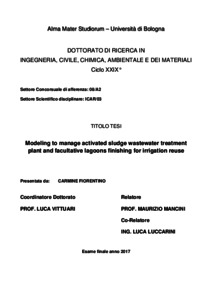Fiorentino, Carmine
(2017)
Modelling to Manage Activated Sludge Wastewater Treatment Plant and Facultative Lagoons Finishing for Irrigation Reuse, [Dissertation thesis], Alma Mater Studiorum Università di Bologna.
Dottorato di ricerca in
Ingegneria civile, chimica, ambientale e dei materiali, 29 Ciclo. DOI 10.6092/unibo/amsdottorato/8054.
Documenti full-text disponibili:
![[img]](http://amsdottorato.unibo.it/8054/1.hassmallThumbnailVersion/Fiorentino_Carmine_tesi.pdf)  Anteprima |
|
Documento PDF (English)
- Richiede un lettore di PDF come Xpdf o Adobe Acrobat Reader
Disponibile con Licenza: Salvo eventuali più ampie autorizzazioni dell'autore, la tesi può essere liberamente consultata e può essere effettuato il salvataggio e la stampa di una copia per fini strettamente personali di studio, di ricerca e di insegnamento, con espresso divieto di qualunque utilizzo direttamente o indirettamente commerciale. Ogni altro diritto sul materiale è riservato.
Download (7MB)
| Anteprima
|
Abstract
In the last years, the role of wastewater treatment plants has become even more relevant not only as final destination of the collected sewage but also as a center of the sustainable approaches for the water cycle. Moreover, the considerable improvements in wastewater treatment control technologies enable now the implementation of advanced sustainable management perspectives. A particular incentive to increase the efficiency of WWTPs performances comes from the possibility to reuse treated wastewater.
In this context, the overall aim of this PhD thesis was to investigate the implementation of models in the most relevant sections of pilot and full-scale plants, and to study the possibility on reusing treated wastewater coming from the effluent flow rate of existing plants for irrigation purpose.
We have implemented the WEST 2012 modeling software that allows different control policies using data acquired on a pilot plant located in Trebbo di Reno (Italy). These simulations have evidenced the real possibility to manage small-scale plants with automatic controller while respecting the legal limits for discharge.
We have also studied the finishing effect of the natural treatment phase using data recorded during several monitoring campaigns on the Santerno full-scale plant located in Imola (Italy). The removal efficiency resulting from the monitoring campaigns reaches 40% for Ammonium and 20% for Total Nitrogen. The disinfection capacity, E. coli removal efficiency up to 40%, does not permit irrigation reuse so appropriate management policies are necessary. In addition, a pilot plant has been designed and implemented in the Santerno area and the first monitoring data show a real possibility to test management policies first in the pilot-plant and then on full scale plant.
Finally, we observed that organic chemicals in wastewater treatment plant have a low biodegradability and can be drastically accumulated during irrigation, which represents a critical issue in the future.
Abstract
In the last years, the role of wastewater treatment plants has become even more relevant not only as final destination of the collected sewage but also as a center of the sustainable approaches for the water cycle. Moreover, the considerable improvements in wastewater treatment control technologies enable now the implementation of advanced sustainable management perspectives. A particular incentive to increase the efficiency of WWTPs performances comes from the possibility to reuse treated wastewater.
In this context, the overall aim of this PhD thesis was to investigate the implementation of models in the most relevant sections of pilot and full-scale plants, and to study the possibility on reusing treated wastewater coming from the effluent flow rate of existing plants for irrigation purpose.
We have implemented the WEST 2012 modeling software that allows different control policies using data acquired on a pilot plant located in Trebbo di Reno (Italy). These simulations have evidenced the real possibility to manage small-scale plants with automatic controller while respecting the legal limits for discharge.
We have also studied the finishing effect of the natural treatment phase using data recorded during several monitoring campaigns on the Santerno full-scale plant located in Imola (Italy). The removal efficiency resulting from the monitoring campaigns reaches 40% for Ammonium and 20% for Total Nitrogen. The disinfection capacity, E. coli removal efficiency up to 40%, does not permit irrigation reuse so appropriate management policies are necessary. In addition, a pilot plant has been designed and implemented in the Santerno area and the first monitoring data show a real possibility to test management policies first in the pilot-plant and then on full scale plant.
Finally, we observed that organic chemicals in wastewater treatment plant have a low biodegradability and can be drastically accumulated during irrigation, which represents a critical issue in the future.
Tipologia del documento
Tesi di dottorato
Autore
Fiorentino, Carmine
Supervisore
Co-supervisore
Dottorato di ricerca
Ciclo
29
Coordinatore
Settore disciplinare
Settore concorsuale
Parole chiave
Wastewater Treatment, Reuse, disinfection kinetics, Nitrogen removal, lagoon, finishing treatment
URN:NBN
DOI
10.6092/unibo/amsdottorato/8054
Data di discussione
16 Maggio 2017
URI
Altri metadati
Tipologia del documento
Tesi di dottorato
Autore
Fiorentino, Carmine
Supervisore
Co-supervisore
Dottorato di ricerca
Ciclo
29
Coordinatore
Settore disciplinare
Settore concorsuale
Parole chiave
Wastewater Treatment, Reuse, disinfection kinetics, Nitrogen removal, lagoon, finishing treatment
URN:NBN
DOI
10.6092/unibo/amsdottorato/8054
Data di discussione
16 Maggio 2017
URI
Statistica sui download
Gestione del documento:


 Login
Login
